How Cinematographer & Director Jessica Lee Gagné Shaped “Severance” Season 2’s Most Devastating Episode
After racking up 14 Emmy nominations for its first season in 2022, Severance returned this spring with a much-ballyhooed set of episodes that fortifies the show’s stature as a dread-saturated mind game drama on par with Twin Peaks and Lost. In the Apple TV+ + series, creepy experiments conducted by cult-like Lumon Industries center on split personalities (Adam Scott, Britt Lower, Zach Cherry, and Dichen Lachmann) wrestling with their “innie/outie” dual identities even as their corporate overlords (Tramell Tillman and Patricia Arquette) try to stay in control.
Filmed almost entirely in New York and New Jersey, the show boasts a strikingly spare aesthetic, shaped by creator-writer Dan Erickson, producer-director Ben Stiller, and producer-DP Jessica Lee Gagné, who makes her directorial debut this year. A native of Quebec City, Gagné first teamed with Stiller on Escape at Dannemora in 2018 on the strength of her indie drama Sweet Virginia. “Quebec has very strong public funding for filmmaking,” she says. “I was able to be a cinematographer right out of college because one of my friends got her movie funded by the government, and that launched us. In Canada, you have access to financing for short films, they get into some festivals, and then you can get a feature made. It’s harder now, but the world I grew up in allowed me to be catapulted as a cinematographer.”
During a visit to Los Angeles, Gagné talks to The Credits about directing, picking the right camera, and curating movie references, including Jane Fonda’s 1971 thriller Klute, that helped inspire the Severance vibe.
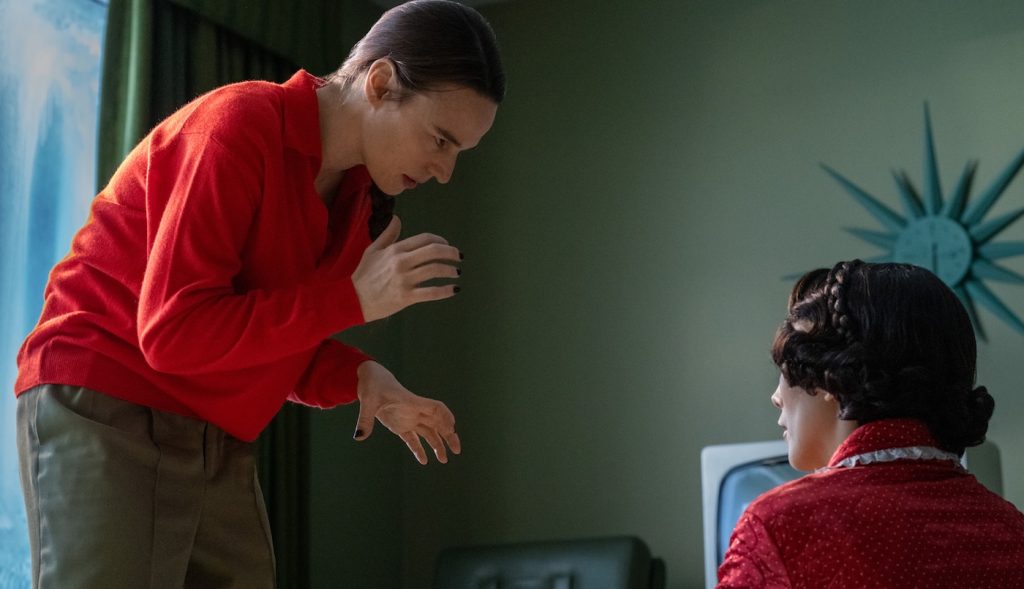
Severance looks like no other show on TV with its restrained color palette and spare compositions. How did you arrive at the visual language for this show?
Through very intense collaboration, and bringing all the creative departments together. Ben does that really well. He made sure all the department heads were present in meetings where we decided what this thing’s going to look like, so everybody knew, for example, where the blue is going to land and how the greens are going to be. There was also a lengthy process of finding references for what our visual language would be be.
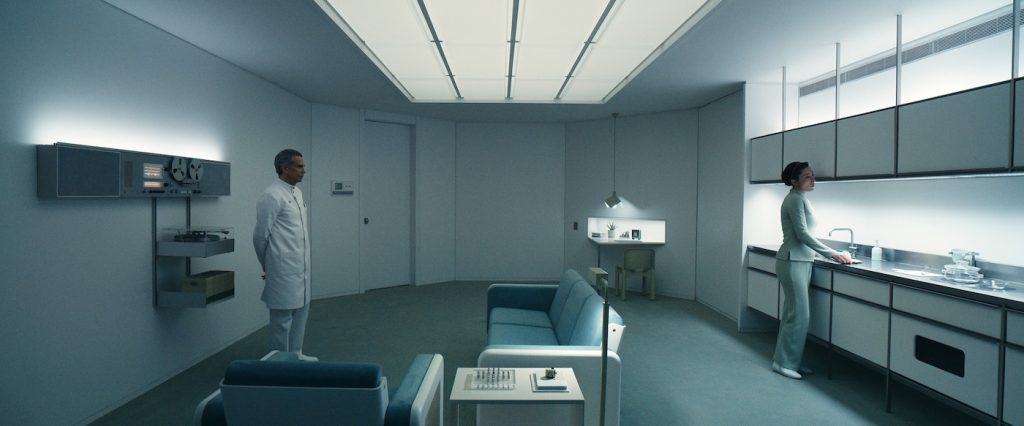
What were some of those key influences?
Three movies that, overall, were big references were The Ipcress File, for its interesting use of foreground and set elements to create unique frames, Playtime, and Klute, for the vibe.
So everybody’s speaking the same visual language?
Not that we all need to like exactly the same things, but when somebody would reference a photographer or another movie or something, there’d be a nod of “Oh yes, we get it.” That creates the language.
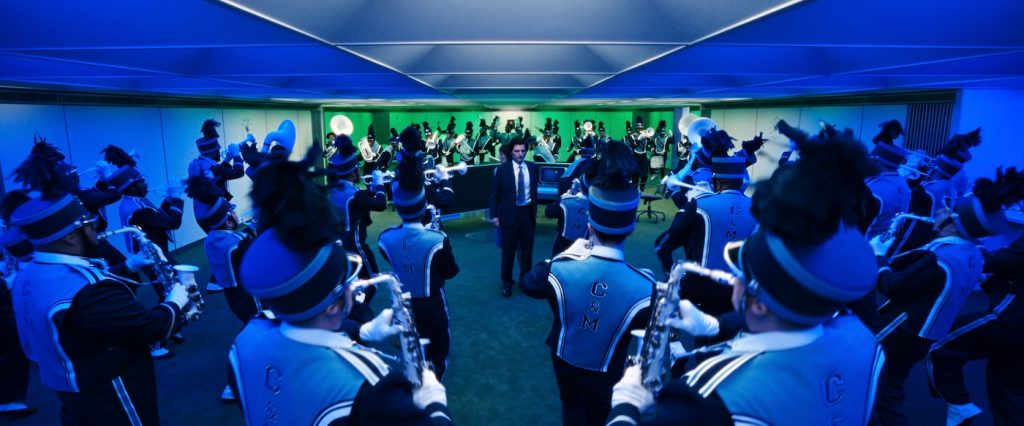
Could you elaborate a bit on the pre-production process?
We conducted a series of tests, and as the DP, I led that process. For the first tests, it was the Sony Venice digital camera versus 35mm film. We watched them with our colorist, Tom Poole, who is an important collaborator because the final coloring stamp has a significant impact on how the show is rendered. Then we tested lenses. Ben is a big fan of the 2.35:1 [wide-screen] format, so we leaned into this kind of halfway world where we used the Sony Venice, which can definitely be contrasty. Mixing that with anamorphic gives you a beautiful texture, which is clinical but still lush.
You worked as DP on six episodes this season and also made your directorial debut in episode 7, “Chikhai Brado.” How did this directing opportunity come about?
It came to me because I wasn’t necessarily wanting to do season 2 as a DP. My favorite part of filmmaking is creating a language and a look, so I was like, “Oh, we’re going to do Severance again?” We’d shot through Covid, I had some PTSD from that [laughing]. And yes, I was thinking of doing something new. But then they offered me [the chance] to direct.
Were you nervous?
It took a minute to wrap my head around that, but when I read the synopsis for Episode 7, I felt a real connection with the themes. I also realized I’d never have an opportunity to work with a crew and cast and producers who knew me so well, so I decided, “This is the moment and it’s not going to happen again.”
In “Chikhai Bardo,” you transmit so much story through imagery – lighting, the characters’ faces, their eyes, their body language – rather than dialogue. For example, not a word is spoken in the flashback when Mark (Adam Scott) finds out his wife Gemma (Dichen Lachmann) is gone.
The moment Mark stands in front of the door and we see the policeman take off their hats — that’s all we needed. It wasn’t necessarily scripted like that, but you think, “How do we make this scene elegant and moving without going over the top?” Because it could have been so heavy. I feel like that’s the beauty of filmmaking: When you really strip things down to the essential, it can become poetic and so moving.
Meanwhile, Gemma is being subjected to painful experiences on Lumon Industries’ “testing floor.” How did you approach those scenes?
It was interesting to show different kinds of torture in each room. I don’t want to use the word “traumatizing,” but they were eerie and off-putting. We’re also dealing with contradictions, like in the Christmas room. It’s cheery, the doctor’s smiling at Gemma, but the fakeness of him playing a game brings this whole thing [of distress] out of her. And then in the dentist’s room, you’re in this sterile place where he has these weapons, and that evokes a different feeling. Everything had a weight, everything had a feeling.
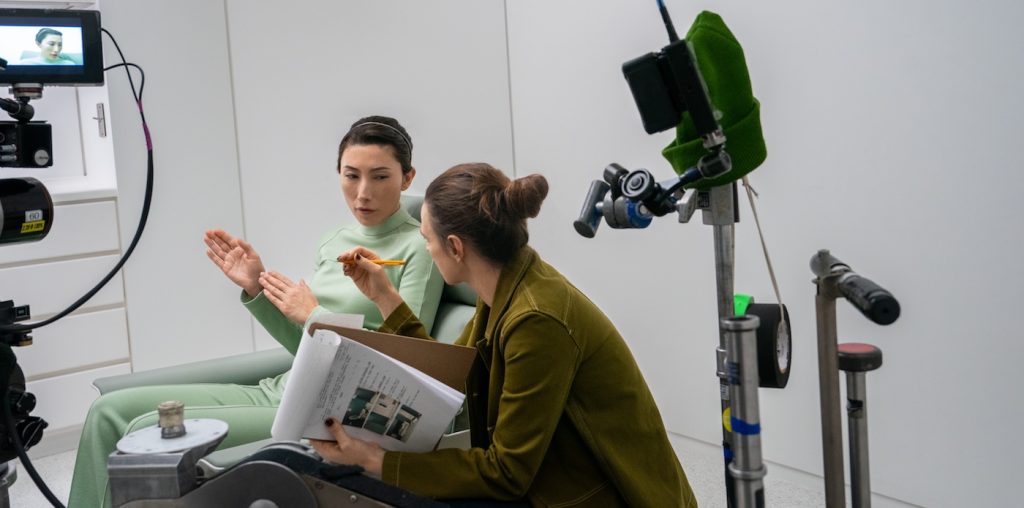
This episode puts Dichen Lachmann front and center for the first time. What was she like to work with?
It was fun to create a complex character who is basically a captive prisoner, with these rooms representing different parts of her. Dichen was creating a new character, so she was very open to exploration.
Did you rehearse?
We rehearsed at the house I’d rented for the whole of season 2. We’d sit in the living room and have casual conversations about what was really happening within each scene, what things were not being said. Adam has been with Mark for so long that he was really prepared. There wasn’t complicated blocking until the end, when I knew exactly how I wanted them to move. “I need you to walk from here to there.” But the rest was very casual.
You worked as director of photography on the provocative season 2 finale. How did you put together that last sequence where Mark abandons Gemma and runs with Helly down this seemingly endless hallway flickering with red and blue lights?
In terms of preparing for that sequence, the most complicated thing was the lighting, so I worked closely with the gaffer and the dimmer board operator.
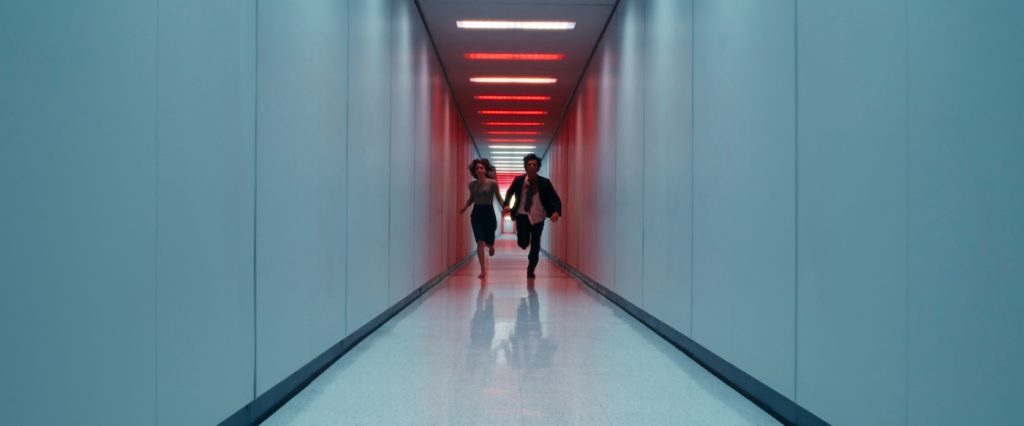
But what about the camera movement behind that tracking shot of Mark and Helly, running, and running, and running?
The sequences on the testing floor were handheld running shots. When we got to the regular MDR [Macrodata Refinement] floor, we were in rickshaw mode for most of that.
What’s “Rickshaw mode?”
The rickshaw is a lightweight dolly that the grips put together with pipes. Nothing fancy, just a contraption basically. Then we attached a remote head to the camera to stabilize it. It allows the grips to run really fast so they can spring down the hallway.
Severance has been filmed almost entirely in New York and New Jersey. Do you appreciate the production’s economic impact on the local filmmaking communities?
It’s really rare to do a show the way we get to do it on Severance. I know people say it’s a big budget, but we were given time and space to create at the highest level we could, and people were getting paid during times like Covid and the strike. The production’s intention has always been to get people to work.
You went straight from still photographer to full-fledged cinematographer. Did that transition come naturally to you?
I gravitated to cameras at a young age, started reading photography books, and quickly went technical with it. Films were also a big part of my life. My dad owned video rental stores, and we went to movies all the time, so there was this strong connection with the medium. In high school, I started shooting little movies with friends, and in film school, I went straight to cinematography.
Now that you’ve had the opportunity to direct, would you like to continue working with actors?
I do! They make me look at parts of myself that I hadn’t really looked at before. Now I feel like I’m more open to that in my life, so I definitely want to go there. And as a director, being able to build a world, step in, and have the final say – that’s really interesting.
Severance seasons 1 and 2 are streaming in their entirety on Apple TV+.
Featured image: Dichen Lachman in “Severance,” now streaming on Apple TV+.



